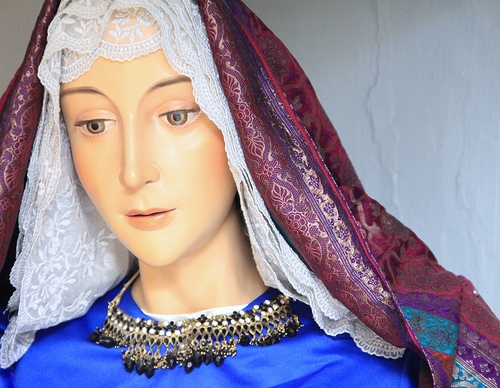JOANNA, friend of Mary Magdalene
Joanna, the unknown disciple who lived with Mary Magdalene and Jesus at Capernaum.
In this small town in the sub-district of Judea, called Galilee, was one of Jesus’ “safe houses.” (Another was the House at Bethany - Mary Magdalene’s home.) Capernaum was not far from the north shore of the Sea of Galilee into which ran the River Jordan. Across the river was the village of Bethsaida, where the disciples Philip and Andrew came from, while to the south of Capernaum was Migdal, once Mary Magdalene’s home, and further to the south of that, Tiberias, Herod’s “new town.” The whole area, by today's standards, was quite small.
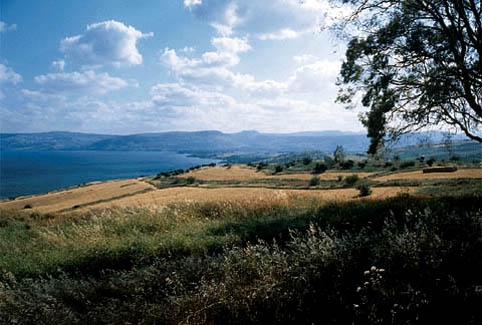
At Capernaum Jesus healed the centurian’s son, so he had friends among the Romans, and he healed the daughter of Jairus, the Pharisee, so a High Priest was on his side. Matthew the tax collector worked on the Roman road just to the west of Capernaum, the Via Maris, making sure the tolls were collected. Jesus used to go drinking with him and his friends.
Capernaum was on the territory of Herod Antipas, but Bethsaida was under the jurisdiction of Herod Philip, so Jesus could escape there if he wished. The other Herod, Archeleaus, ruled the Jerusalem area.
The Herod family were despised by the Jews, and Herod Antipas was particularly Jesus’ enemy after the imprisonment and then beheading of John the Baptist. John was imprisoned soon after Jesus was baptised, and St Matthew says; After John had been put in prison, Jesus went to Galilee and preached the good news from God. Jesus chose his disciples who were also his bodyguards and then made Capernaum his headquarters. Jesus and his disciples lived in the house of Peter the fisherman, which was large enough to accommodate many people.
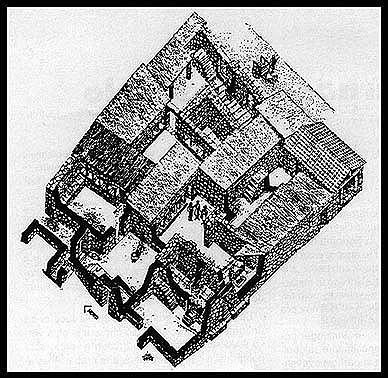 Peter's house - archeological reconstruction
Peter's house - archeological reconstruction
And then? Jesus travelled through towns and villages, preaching the Good News and the Kingdom of God. The twelve disciples went with him, and so did some women who had been healed of evil spirits and diseases; Mary called the Magdalene from whom seven demons had been driven out; Joanna, whose husband Chuza was a officer in Herod’s court, and Susanna, and many other women, who used their own resources to help Jesus and his disciples.
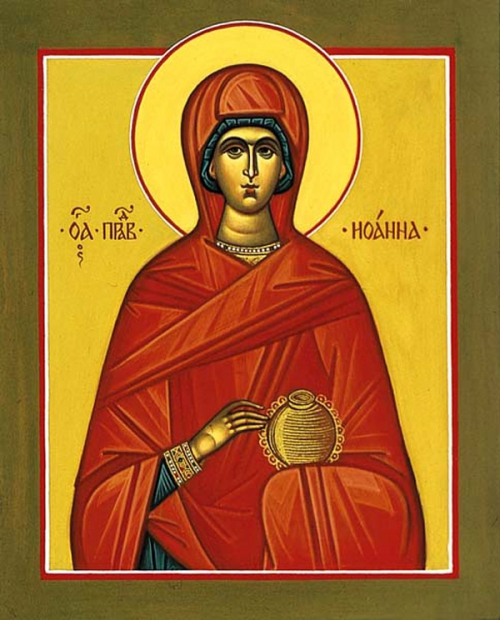
And so we meet Joanna for the first time. Her name means; Yahweh has been gracious. Her husband was a wealthy man; he was what we would call today the Head Steward, running Herod’s palace and household in a superior position. An ossuary was found in 1986 at Hizma, 7km from Jerusalem, and the inscription said; “Johanna, daughter of Johanan, son of Theophilus, the High Priest.” Theophilus the High priest died around 37AD and many think this ossuary contained the bones of his grand daughter Joanna. If so, she came from a high-ranking family.
Herod’s court was at Tiberias where Herod lived, only a few miles away from Capernaum. It was built by Herod around 20AD, on top of an old Jewish cemetery despite all the Galilean protests, with funds from excessive taxation. Tiberias was one of the “aggressive acts of Romanization by Antipas”; the result was that the people of Galilee hated those courtiers who lived there.
So what was Joanna, Chuza’s wife doing, joining the disciples, who were anti-Herod, and traveling with them? It was unlikely that she would have been there with her husband’s consent; the political system would never have allowed it. French historians think therefore, that she was Chuza’s widow. I’m not so sure.
We read in Matthew’s Gospel, 14, 1 - 12, that Herod heard about Jesus and said to his officials (which included Chuza and/or his wife?) “He is John the Baptist, come back to life, that’s why he has the power to perform miracles.” John the baptist had continually told Herod (which implies John the Baptist was of high rank too) that Herod was wrong in marrying the wife of his brother Philip, Herodias. John was put in prison but not executed, because Herod was courting the popularity of the people.
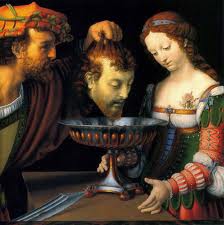
On Herod’s birthday (all the court present?) Herodias’s daughter, urged on by her mother, demanded the head of John the Baptist. John was beheaded, and the still-warm head brought into the room, and the daughter presented it to Herodias, confirming her triumph against the man who condemned her marriage. Later, it says, John’s followers came for John’s remains, and decently buried him, and then told Jesus. It seems however, they only buried his body.
Then I found something amazing. According to Eastern tradition, when Herod had John the Baptist beheaded, Herodias later threw the head onto a dung-heap. Joanna retrieved the head and buried it with honour on the Mount of Olives, on Herod’s land. Later, in the reign of Constantine the Great, the head was found. I'm not sure I believe this story.
If Joanna was there at the birthday party, and witnessed Herodias demanding the head, and then found John’s head in this horrible way, and then helped bury John’s remains with the other disciples, we can understand she was distressed. John was beheaded on the 29th August in the heat; imagine trying to get a decent burial for him before sunset, as was the Jewish custom. Also, in Jewish custom, it was women who cleaned and prepared bodies for burial. One can understand why Joanna wanted to leave.
By my calculation, she joined Jesus at Capernaum in Autumn 31AD, when Mary Magdalene was already there.
Maybe Joanna was healed, as Mary Magdalene was, by Jesus because she was ill after the stress she had gone through. I found a quote from Matthew that might be relevant; after Jesus had healed the Roman Officer’s servant at Capernaum, 8 verse 16; When evening came, people brought to Jesus many who had demons in them. Jesus drove out the evil spirits with a word and healed all who were sick. "Evil spirits" meant sickness; it did NOT mean satanic possession!
The other woman mentioned in Luke’s “women of substance” list, Susanna, was, I believe, Jesus’ sister Susanna. I don’t know where I got this idea from, the names of his sisters are not given in the Bible. Scholars suspect the ladies were named in order of rank; Mary Magdalene, Joanna, then Susanna.
Some think Joanna was a secret Christian before she left Herod's court, hinting she could have gained entrance when many others could not within Herod’s Palace itself. Tradition suggests that Chuza lost his position in Herod’s palace because of his wife Joanna’s conversion to Christianity and her courageous testimony among Herod’s servants. This implies Joanna had multiple reasons for joining Jesus; maybe her life was in danger.
The American Coptic church says; Chuza, being the Tetrarch’s steward, was a man of high position managing Herod's income. Such an important position would have earned him a good salary, enabling him to provide high-quality living for his family. Therefore, Joanna being a wealthy woman had all the means needed to travel and follow the Lord wherever He went and support Him in His mission on earth.
This is echoed by www.aletheiacollege.net which surmises that the disciples left their wives and families to defend for themselves, and accepted the financial support of several wealthy women. It was sociologically impossible that wealthy women should support illiterate men in such an itinerant lifestyle. . . . the wealthy simply didn’t mix with the lower classes . . . it could only be the compelling personality of Jesus which led Joanna to do something as scandalous as she did. Then the writer says that maybe Joanna was divorced according to Jewish law and received a financial settlement which she could use as she wished. The truth was of course that the "Jesus movements" asked followers for contributions, just as preachers do today.
I’m not sure Jesus’s “compelling personality” (impying something sexual) was Joanna’s main motivation. She was converted to Christianity, quite simply. Also, the disciples never deserted their families and their work; there are stories of Jesus going fishing with them and ensuring a good catch. This author had forgotten the famous words in Acts 2, 44 to 47. All the believers continued together in close fellowship and shared their belongings with one another. They would sell their property and possessions, and distribute the money along all, according to what each one needed. Communism, no less!
Indeed, the situation was political. Judea had been in revolt against their Roman occupiers since 63BC (and the battle against occupation continued until 74AD, when the last Jewish resistance was brutally squashed). By standing as Messiah, a God-King who would save his people, Jesus was entering the Jewish rebellion against the Romans. Herod was unimportant, being merely a puppet-king, but Herod wanted to protect his position naturally. One day, as it says in Luke, 13, 31 - 32, the Pharisees said to Jesus, clear out now because Herod will kill you. Jesus said, “Go and tell that fox that I cast out devils and I do cures today and tomorrow.” He was much more the God-King of the Jews than Herod was.
The disciples at Capernaum also shared the work, which included that in the house as well as that on the road. It was important for the disciples to consist of men and women, so both could address the concerns of their would-be followers. The disciples also gave money to the poor, as shown by Judas’ criticism when Mary Magdalene anointed Jesus with costly oil; “The money for that ointment could have been given to the poor.”
Although Joanna joined the Christian group several months into Jesus’ ministry, working together in this way would have brought the woman close, and it’s believed Joanna and Mary Magdalene were close. Michael Donley, who wrote a book about Mary Magdalene in Provence, thinks that maybe Mary Magdalene, as a wealthy women in her own right, might also have visited Herod’s court, and that the two women became friends then. Later, they might even have gone together to see Jesus baptised by John. This gives us a mental picture of Joanna suffering at that heartless place, until the execution of John the Baptist finally persuaded her to flee to her friend at Capernaum, who asked Jesus to heal her.
Later, Mary Magdalene and Joanna both witnessed the crucifixion and went to cleanse Jesus’ body on the Sunday afterwards. Hence they, and the other woman, are called the Myrrh-bearers by the Church who gave them a feast day of 27th June in the east and 24th May in the west.
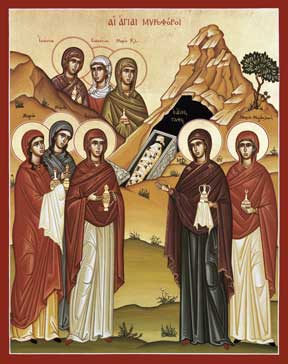
Wikipedia lists eight women who have this title, but we can miss out Mary of Bethany, for we believe she was Mary Magdalene. The seven are; Mary Magdalene, the Virgin Mary, (in one case described as Mary, the mother of James and Joseph), Joanna, Mary Salome (the wife of Zebedee and mother of the fishermen disciples, John and James,) Mary the wife of Cleophas, then Susanna and then Martha of Bethany (Mary Magdalene’s sister.) The last two, apparently, were added by the Church as a courtesy!
It’s interesting that the name of Susanna crops up, she is not actually mentioned as being at either event. However, the phrase “the women of Galilee” does crop up, especially in Luke, who meant Mary Magdalene, Joanna and Susanna by this phrase, plus their maids. Luke, we must remember, was a Greek doctor who travelled with St. Paul and not from Galillee, which was a small, little-known province; so where did he get his information from? (I’ll tell you later.)
The crucifixion
"The women of Galilee” followed Jesus faithfully and traveled with him when he went to Jerusalem to make his triumphant entry there. And they witnessed the crucifixion. St.Matthew, 27, 55 and 56 and Mark, 15, 40); There were many women there, looking on from a distance, Mary the mother of James and Joseph, and the wife of Zebedee. Luke says in 24, 49; All those who knew Jesus personally, including the women who had followed him from Galilee, stood at a distance to watch. (Here he is in error - the male disciples were not there, except possibly Lazarus.) In St. John, 19,25, Standing close to Jesus’s cross were his mother, Mary the wife of Clophas, and Mary Magdalene.
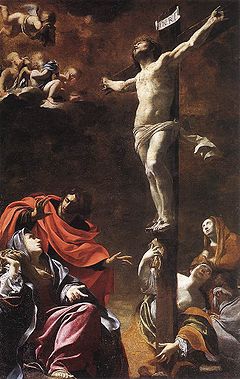
Two days later - the ressurrection. St Matthew tells us that Mary Magdalene and “the other Mary” went to the tomb. (28, 1- 10) St. Mark tell us that Mary Magdalene, Mary the mother of James and Mary brought spices to anoint the body of Jesus. 16 1 - 8. In St. John, the only woman concerned was Mary Magdalene. 20 1 - 18. Luke (please note) names the women as Mary Magdalene, Joanna and the mother of James. 24, 1 - 12. The passage is worth quoting in full; Very early on the Sunday morning the women went to the tomb, carrying the spices they had prepared. They found the stone rolled away from the entrance to the tomb, so they went in; but they did not find the body of the Lord Jesus. They stood there puzzled about this, when suddenly two men in bright shining clothes stood by them. Full of fear, the women bowed down to the ground, as the men said to them; "Why are you looking among the dead for one who is alive? he is not here; he has been raised. Remember what he said to you while he was in Galilee: The Son of Man must be handed over to sinners, be crucified, and three days later rise to life." Then the women remembered his words, returned from the tomb, and told all these things to the eleven disciples and all the rest. The women were Mary Magdalene, Joanna and Mary the mother of James; they and the other women with them told these things to the apostles. But the apostles thought that what the women had said was nonsense, and they did not believe them.
Luke’s “witnesses.”
Wikipedia tells us that Joanna was listed in Acts as one of Luke’s witnesses to the events of the life of Jesus because she was among the apostles, as we know from the “substance” verses, but again, not mentioned by name.
Also in Acts is the story of how the replacement for missing disciple Judas was chosen. The disciples gathered frequently to pray as a group, together with the women, and with Mary the mother of Jesus and his brothers. The woman aren’t named, but many Bible scholars conclude that Joanna was among them. Others claim that Mary Magdalene was too, but I think she was with Jesus, wherever he was. The disciples had gathered to vote for the new disciple to make up the twelve (they chose Matthias) but it intrigues me - why did they have to have 12? I think there is some mystic significance going on here along the lines of the 3 attributes and the 4 attributes mixed together to make the signs of the Zodiac in astrology, or the Gemetria of Margaret Starbird.
Another intriguing point; why was not Lazarus that Jesus loved, as it says in the Bible, not chosen? I believe this is because,like Mary Magdalene, he wasn’t there. He too had gone to France, to Marseille.
So what happened to Joanna next? To my surprise, many websites said she was the same woman called Junia by Paul in his epistle to the Romans, 16, verse 17; Greetings also to Andronicus and Junia, fellow Jews who were in prison with me; they are well-known among the apostles, and they became Christians before I did. So when did Paul become a Christian and when was he in prison? And how come Joanna went to Rome?
Paul became a Christian after the brutal torture and death, which he participated in, of Stephen the first martyr in 34AD, and it’s calculated that his conversion on the road to Damacus took place in 36AD. Paul was imprisoned in Caesarea by the Romans in 57AD, but he was a Roman citizen and had the right to appeal to the Emperor, so he was set free to Rome in 59AD. And there he greeted Joanna, who had been in prison with him? that doesn’t make sense.
There was an earlier prison incident. Paul left Jerusalem for his second missionary journey to Philippi, in late Autumn 49. In Philippi Paul, travelling with Silas, cast a spirit of divination out of a servant girl, whose masters were then unhappy about the loss of income her soothsaying provided. (Acts 16:16–24) They turned the city against the missionaries, and Paul and Silas were put in jail. After a miraculous earthquake, the gates of the prison fell apart and Paul and Silas could have escaped but remained; this event led to the conversion of the jailor. (Acts 16:16–40) There were no other prisoners; it’s unlikely that “Junia” of Rome was with them there. If so, she must have travelled everywhere with them, but there is no mention of her anywhere else.
When a famine occurred in Judea, around 45–46, Paul and Barnabas delivered financial support from the Antioch community to Jerusalem.
According to Acts, Antioch had become an alternative centre for Christians following the dispersion of the believers after the death of Stephen in 34AD. It was in Antioch that the followers of Jesus were first called "Christians". (Acts 11:19-30) It says that about that time some prophets went from Jerusalem to Antioch. I think Johanna would have been among them, in those very early days.
Both the Gospel of Luke, and Acts, were written by Luke who was traveling with Paul. In Luke’s Gospel there are 13 separate references to Herod, only 4 of which can be found in the other Gospels, thus 9 of his references came from a source that cannot be traced. Could that source have been Joanna, as the wife of Herod's steward? Could she have told Luke of the splendid style in which Antipas and his officials lived? (Luke, 9, 7 - 9, , Luke 23, 6 - 12) In Luke there are many tales of what Jesus said and did that are not in the other Gospels. Could this be the input of Joanna? Did Luke “interview” her at Antioch? Luke is often known as the “novelist” among the Apostles, because he writes so well.
Now there’s something else interesting! Luke names five prophets and teachers in the church at Antioch. This was just after Herod had ordered the execution of James, the brother of John, and slapped Peter into prison, but Peter escaped. In addition to Barnabas and Saul he also names (13, verse 1 -2,) Simeon who was called Niger, and Lucius of Cyrene, and Manaen who had been brought up with Herod the Tetrarch. (Herod Antipas.) These prophets felt the Holy Spirit advise them to send Saul and Barnabas on their first missionary journey - to Cyprus. There they converted Paulus Sergius the governer, who later came to Narbonne.
Manaen was Herod’s foster-brother. Luke, who seemed fascinated by Herod, would have “interviewed” him too. A person of high rank was part of the Antioch church. He had converted and, like Joanna, left Herod’s palace. And Joanna would have known him, they would have been companions at Antioch. The first Christian church. I wondered if they travelled there together, some ten years previously? If so, Joanna deserves more glory. Wikipedia thinks that Manaen founded the Antioch church, and Joanna would have been with him.
She was a courageous woman, like Mary Magdalene, who loved Jesus.
Footnote; In Luke’s gospel there is no mention of Herod’s birthday party and the head of John the Baptist, and Josephus, in his History of the Jews, tells us merely that Herod put John to death because the people believed in him so much. It’s interesting then, that John was arrested so soon after he handed the reins over to Jesus, and that Herod threatened to execute Jesus too; if he could have got hold of him. Meanwhile, I suspect the whole grisly tale about the head of John the Baptist was a myth that developed after Luke wrote his gospel, which was one of the earliest.
Click here for more about Capernaum.
http://www.ucatholic.com/saints/saint-joanna/ for the story of Joanna and John’s head.
Click here for more about Paulus Sergius
A beautiful modern interpretation of Joanna.
Inscrivez-vous au site
Soyez prévenu par email des prochaines mises à jour
Rejoignez les 261 autres membres

